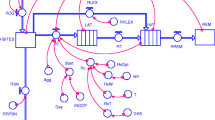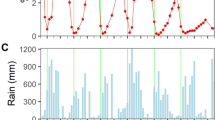Abstract
Brazil is the major coffee producer in the world, with 2 million hectares cropped, with 75% of this area with Coffea arabica and 25% with Coffea canephora. Coffee leaf rust (CLR) is one of the main diseases that cause yield losses by reducing healthy leaf area. As CLR is highly influenced by weather conditions, this study aimed to determine the best linearization model to estimate the CLR apparent infection rate, to correlate CLR infection rates with weather variables, and to develop and assess the performance of weather-based infection rate models to be used as a disease warning system. The CLR epidemic was analyzed for 88 site-seasons, while progress curves were assessed by linear, monomolecular, logistic, Gompertz, and exponential linearization models for apparent infection rate determination. Correlations between CLR infection rates and weather variables were conducted at different periods. From these correlations, multiple linear regressions were developed to estimate CLR infection rates, using the most weather-correlated variables. The Gompertz growth model had the best fit with CLR progress curves. Minimum temperature and relative humidity were the weather variables most correlated to infection rate and, therefore, chosen to compose a CLR forecast system. Among the models developed, the one for the condition of high coffee yield at a narrow row spacing was the best, with only 9.4% of false negative occurrences for all the months assessed.



Similar content being viewed by others
References
Avelino J, Cristancho M, Georgiou S et al (2015) The coffee rust crises in Colombia and Central America (2008–2013): impacts, plausible causes and proposed solutions. Food Secur 7:303–321. https://doi.org/10.1007/s12571-015-0446-9
Bergamin Filho A (2011) Curvas de progresso das doenças. In: Amorim L, Rezende JAM, Bergamin Filho A (eds) Manual de Fitopatologia – Princípios e Conceitos, 4th edn. São Paulo, pp 647–666
Bergamin Filho A, Amorim L (1996) Doenças de plantas tropicais: epidemiologia e controle econômico, 1st edn. Editora Agronômica Ceres, São Paulo
Berger RD (1981) Comparison of the Gompertz and logistic equations to describe plant disease progress. Phytopathology 71:716–719
Bock KR (1962) Seasonal periodicity of coffee leaf rust and factors affecting the severity of outbreaks in Kenya Colony. Trans Br Mycol Soc 45:289–300. https://doi.org/10.1016/S0007-1536(62)80068-0
de Camargo AP, de Camargo MBP (2001) Definição e esquematização das fases fenológicas do cafeeiro arábica nas condições tropicais do Brasil. Bragantia 60:65–68. https://doi.org/10.1590/S0006-87052001000100008
de Camargo AP, Pereira AR (1994) Agrometeorology of the coffee crop. Switzerland, Geneva
Camargo AP de, Sentelhas PC (1997) Performance evaluation of different potential evapotranspiration estimating methods in the state of São Paulo, Brazil. Rev Bras Agrometeorol 5:89–97
Campbell CL, Madden LV (1990) Introduction to plant disease epidemiology. John Wiley & Sons, New York
Chalfoun SM (1997) Doenças do cafeeiro: importância, identificação e métodos de controle, First. FAEPE, Lavras
Conceição CHC, Guerreiro-Filho O, Gonçalves W (2005) Flutuação populacional do bicho-mineiro em cultivares de café arábica resistentes á ferrugem. Bragantia 64:625–631. https://doi.org/10.1590/S0006-87052005000400012
DaMatta FM, Ronchi CP, Maestri M, Barros RS (2007) Ecophysiology of coffee growth and production. Brazilian J Plant Physiol 19:485–510. https://doi.org/10.1590/S1677-04202007000400014
Duttweiler KB, Gleason ML, Dixon PM et al (2008) Adaptation of an apple sooty blotch and flyspeck warning system for the Upper Midwest United States. Plant Dis 92:1215–1222. https://doi.org/10.1094/PDIS-92-8-1215
Gillespie TJ, Srivastava B, Pitblado RE (1993) Using operational weather data to schedule fungicide sprays on tomatoes in southern Ontario. Canada Am Meteorol Soc 22:567–573
Gleason ML, MacNab AA, Pitblado RE et al (1995) Disease-warning systems for processing tomatoes in eastern North America: are we there yet? Plant Dis 79:113. https://doi.org/10.1094/PD-79-0113
Godoy CV, Bergamin Filho A, Salgado CL (1997) Doenças do cafeeiro. In: Kimati H, Amorim L, Bergamin Filho A et al (eds) Manual de Fitopatologia – Doenças das Plantas Cultivadas, 3rd edn. Editora Agronômica Ceres Ltda., São Paulo, pp 178–192
Huang YJ, Powers R, Montelione GT (2005) Protein NMR recall, precision, and F-measure scores (RPF scores): structure quality assessment measures based on information retrieval statistics. J Am Chem Soc 127:1665–1674. https://doi.org/10.1021/ja047109h
ICO (2017) International coffee organization. In: Total Prod. by all Export. Ctries. http://www.ico.org/prices/po-production.pdf. Accessed 15 Dec 2017
Instituto Brasileiro de Geografia e Estatística (IBGE) (2017) Levantamento Sistemático da Produção Agrícola - Pesquisa Mensal de Previsão e Acompanhamento das Safras Agrícolas no Ano Civil
Japiassú LB, Garcia AWR, Miguel AE et al (2007) Influência da carga pendente, do espaçamento e de fatores climáticos no desenvolvimento da ferrugem do cafeeiro. Simpósio Pesqui dos Cafés do Bras:171–175
Jayakumar M, Rajavel M, Surendran U (2016) Climate-based statistical regression models for crop yield forecasting of coffee in humid tropical Kerala, India. Int J Biometeorol 60:1943–1952. https://doi.org/10.1007/s00484-016-1181-4
Kim CH, MacKenzie DR, Rush MC (1988) Field testing a computerized forecasting system for rice blast disease. Phytopathology 78:931–934
Kushalappa AC (1989) Rust management: an epidemiological approach and chemical control. In: Kushalappa AC, Eskes AB (eds) Coffee rust: epidemiology, resistance, and management, first. CRC Press, Boca Raton, Florida, pp 81–140
Kushalappa AC, Akutsu M, Ludwig A (1983) Application of survival ratio for monocyclic process of Hemileia vastatrix in predicting coffee rust infection rates. Phytopathology 73:96. https://doi.org/10.1094/Phyto-73-96
Kushalappa AC, Akutsu M, Oseguera SH et al (1984) Equations for predicting the rate of coffee rust development based on net survival ratio for monocyclic process of Hemileia vastatrix. Fitopatol Bras 9:255–271
Kushalappa AC, Chaves GM (1980) An analysis of the development of coffee rust in the field. Fitopatol Bras 5:95–103
Kushalappa AC, Eskes AB (1989) Coffee rust: epidemiology, resistance and management, 1st edn. CRC Press, Boca Raton, Florida
Kushalappa AC, Hernandez TA, Lemos HG (1986) Evaluation of simple and complex coffee rust forecasts to time fungicide application. Fitopatol Bras 11:515–526
López-Bravo DF, de Virginio-Filho E, M, Avelino J (2012) Shade is conducive to coffee rust as compared to full sun exposure under standardized fruit load conditions. Crop Prot 38:21–29. https://doi.org/10.1016/j.cropro.2012.03.011
Madden L, Pennypacker SP, MacNab AA (1978) FAST, a forecast system for Alternaria solani on tomato. Phytopathology 68:1354–1358. https://doi.org/10.1094/Phyto-68-1354
Magarey RD, Isard SA (2017) A troubleshooting guide for mechanistic plant pest forecast models. J Integr Pest Manag 8:1–7. https://doi.org/10.1093/jipm/pmw015
McCook S (2006) Global rust belt: Hemileia vastatrix and the ecological integration of world coffee production since 1850. J Glob Hist 1:177–195. https://doi.org/10.1017/S174002280600012X
Meira CAA, Rodrigues LHA, de MSA (2009) Modelos de alerta para o controle da ferrugem-do-cafeeiro em lavouras com alta carga pendente. Pesqui Agropecu Bras 44:233–242. https://doi.org/10.1590/S0100-204X2009000300003
Meira CAA, Rodrigues LHA, Moraes SA (2008) Análise da epidemia da ferrugem do cafeeiro com árvore de decisão. Trop Plant Pathol 33:114–124
Moraes SA de, Sugimori MH, Ribeiro IJA, et al. (1976) Incubation period of Hemileia vastatrix B. et Br. in three regions of São Paulo State. Summa Phytopathol 2:32–38
Neto CDG, Rodrigues LHA, Thamada T, Meira CAA (2013) Warning models for coffee rust (Hemileia vastatrix Berkeley & Broome) by data mining techniques. 6
Nutman FJ, Roberts FM, Clarke RT (1963) Studies on the biology of Hemileia vastatrix Berk. & Br. Trans Br Mycol Soc 46:27–44. https://doi.org/10.1016/S0007-1536(63)80005-4
Nutter FWJ (1997) Quantifying the temporal dynamics of plant virus epidemics: a review. Crop Prot 16:603–618. https://doi.org/10.1016/S0261-2194(97)00055-0
Reis EAC, Freitas T, de Carvalho ML, F et al (2018) Characterization of coffee cultivares leaf-resistant subjected to framework pruning. Coffee S 13:63–70
Rowlandson T, Gleason M, Sentelhas PC et al (2015) Reconsidering leaf wetness duration determination for plant disease management. Plant Dis 99:310–319. https://doi.org/10.1094/PDIS-05-14-0529-FE
Sentelhas PC, Dalla Marta A, Orlandini S et al (2008) Suitability of relative humidity as an estimator of leaf wetness duration. Agric For Meteorol 148:392–400. https://doi.org/10.1016/j.agrformet.2007.09.011
Souza AGC, Rodrigues FÁ, Maffia LA, Mizubuti ESG (2011) Infection process of cercospora coffeicola on coffee leaf. J Phytopathol 159:6–11. https://doi.org/10.1111/j.1439-0434.2010.01710.x
Thomas CS, Skinner PW, Fox AD et al (2002) Utilization of GIS/GPS-based information technology in commercial crop decision making in California. J Nematol 34:200–206
Wallin JR (1962) Summary of recent progress in predicting late blight epidemics in United States and Canada. Am Potato J 39:306–312
Willmott CJ (1981) On the validation of models. Phys Geogr 2:184–194
Xavier AC, King CW, Scanlon BR (2015) Daily gridded meteorological variables in Brazil (1980–2013). Int J Climatol 36:2644–2659. https://doi.org/10.1002/joc.4518
Zambolim L (2016) Current status and management of coffee leaf rust in Brazil. Trop Plant Pathol 41:1–8. https://doi.org/10.1007/s40858-016-0065-9
Zambolim L, Vale FXR, Pereira AA, Chaves GM (1997) Café (Coffea Arabica L.): controle de doenças – doenças causadas por fungos, bactérias e virus. In: Vale FXR, Zambolim L (eds) Controle de doenças de plantas: grandes culturas. pp 83–140
Zambolim L, Vale FXR, Zambolim EM (2005) Doenças do Cafeeiro. In: Kimati H, Amorim L, Rezende JAM et al (eds) Manual de Fitopatologia – Doenças das Plantas Cultivadas, 2nd edn. Editora Agronômica Ceres Ltda, São Paulo, pp 165–180
Acknowledgements
This research was supported by funds from FAPESP (São Paulo Research Foundation), Brazil, under the process number 2014/17781-8. The disease incidence and weather data were gently provided by Fundação Procafé.
Author information
Authors and Affiliations
Corresponding author
Rights and permissions
About this article
Cite this article
Hinnah, F.D., Sentelhas, P.C., Meira, C.A.A. et al. Weather-based coffee leaf rust apparent infection rate modeling. Int J Biometeorol 62, 1847–1860 (2018). https://doi.org/10.1007/s00484-018-1587-2
Received:
Revised:
Accepted:
Published:
Issue Date:
DOI: https://doi.org/10.1007/s00484-018-1587-2




